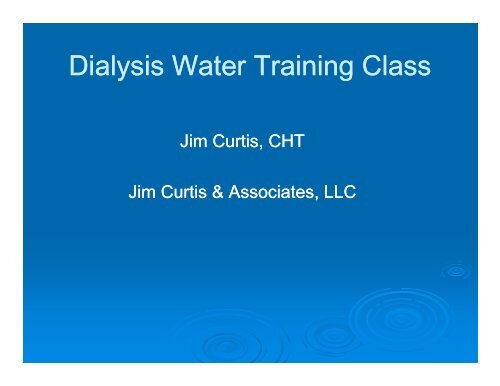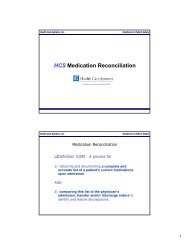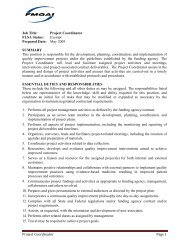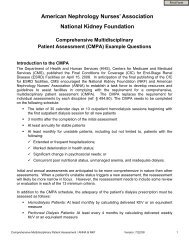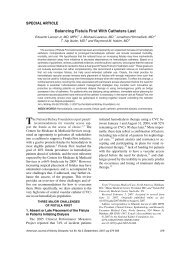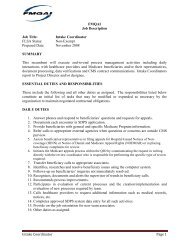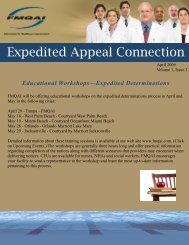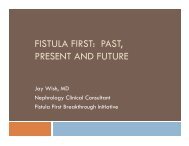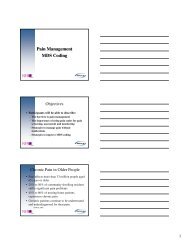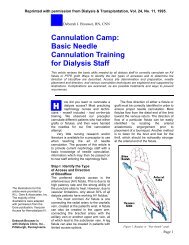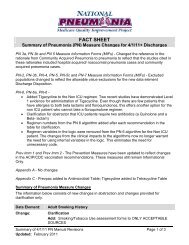Dialysis Water Training Class - FMQAI
Dialysis Water Training Class - FMQAI
Dialysis Water Training Class - FMQAI
- No tags were found...
You also want an ePaper? Increase the reach of your titles
YUMPU automatically turns print PDFs into web optimized ePapers that Google loves.
<strong>Dialysis</strong> <strong>Water</strong> <strong>Training</strong> <strong>Class</strong>Jim Curtis, CHTJim Curtis & Associates, LLC
<strong>Water</strong> Basics‣ <strong>Water</strong> is the Universal Solvent• It will change almost anything it comes incontact with• It will Be changed by almost anything intouches‣ <strong>Water</strong> affects EVERY dialysis treatment
<strong>Water</strong> Basics‣ There are Four primary categories ofcontaminates found in <strong>Water</strong>• Particulate• Inorganics• Organics• Microbiological
<strong>Water</strong> Basics‣ Particulate Matter Includes:• Sediment• Suspended Solids• Grit• Sand
<strong>Water</strong> Basics‣ Inorganic Material is the IonicConcentration found in water• Dissolved Salts• Other dissolved solids• Hardness‣ Common Inorganic material found in water• Calcium, Magnesium, Sodium, Potassium,Zinc, Nitrates, Lead, Copper, Aluminum, etc.
<strong>Water</strong> Basics‣ Organic Material often come in morecomplex chemical compounds.‣ Examples include chloramines, pesticides,insecticides, tannins‣ Can be a result of either natural or man-made causes.
<strong>Water</strong> Basics‣ Microbiological Contaminates include:• Bacteria and Bacterial Endotoxin• Viruses• Cysts• Protozoan's‣ These substances vary greatly in size andshape‣ Different problems are encountered witheach
<strong>Water</strong> Terms You Should Know‣ Source <strong>Water</strong>: Where the water originallycomes from. Generally the two sources areGround <strong>Water</strong> that comes from wells, andSurface <strong>Water</strong> which comes from lakes andrivers.‣ Feed <strong>Water</strong>: This is the water “feeding” yourtreatment system, and is often treated by themunicipality before it gets to you.
<strong>Water</strong> Terms You Should Know‣ Pre-Treatment:Treatment: These are the devices thatyou yse to treat the water prior to the ReverseOsmosis or DI device.‣ Reverse Osmosis: This is a process wherehydraulic pressure is used to overcome theosmotic pressure and cause water to move fromareas of high solute concentration to areas ofLow solute concentration.Permeate: <strong>Water</strong> that has passed through theRO membrane- “Product” water‣ Permeate:
<strong>Water</strong> Terms You Should Know‣ Concentrate: This is the waste water from theRO, which now has a higher concentration ofsolutes that the feed water did.‣ Filtration (or Depth Filtration): Removal ofsuspended particles by mechanically trappingthem in a filter media.• Submicron Filtration: Removing particles lessthan1microninsize.in • Ultrafiltration: Removing particles from .002 to.1 microns.
<strong>Water</strong> Terms You Should Know‣ Ion Exchange: Exchange of one ionic particle foranother• Cation: Positively Charged particle• Anion: Negatively charged particle• Deionization: Removal of charged particles fromwater by means of ion exchange.Chloramines: Chemical used to disinfectmunicipal i water supplies. They are formed bycombining chlorine and ammonia.‣ Chloramines:
<strong>Water</strong> Terms You Should Know‣ Hardness: Refers to the sum of calciumand magnesium in the water• Expresses in Grains per Gallon of CalciumCarbonate (1 GPG = 17.1 mEq/L)• Primary source of scaling that fouls ROmembranes.
<strong>Water</strong> Terms You Should Know‣ pH: Potential of Hydrogen‣ Quantitative measurement of the acidity oralkalinity on a logarithmic scale from 1 to14• pH > 7 = Alkaline (base)• pH = 7 = Neutral• pH < 7 = Acidic
<strong>Water</strong> Terms You Should Know‣ Microorganism: Small living organismssuch as Bacteria, Virus or Ptotozoan.‣ Colony Forming Units (CFU): Themeasurement of viable colonies ofbacteria in a culture sample‣ Biofilm: A gelatinous material secreted bycertain bacteria that can adhere to thewalls of piping and forms a protectivecoating
<strong>Water</strong> Terms You Should Know‣ Endotoxin: A lipopolysaccoride that is partof cell walls of gram negative bacteria‣ LAL: Limulus Amebocyte Lysate, a test forbacterial endotoxin derived from intestinalfluid of horseshoe crabs.‣ Endotoxin Units (EU): Quantitativemeasurement of the amount of Endotoxincontamination in a solution.
Importance of Monitoring‣ Increases Patient Safety‣ Maintain Regulatory Compliance‣ Assures Proper Functioning i of <strong>Water</strong>Treatment System
<strong>Water</strong> for Hemodialysis is aPrescription‣ More than 95% of the dialysate is water‣ The Doctor makes the ultimate decisionregarding water quality???‣ <strong>Water</strong> treatment systems for dialysispurposes are considered d a <strong>Class</strong> IIMedical Device by the FDA
Exposure to <strong>Water</strong> andContaminants‣ Average Population• Drinks approximately14 L/week (2 L/day)• Able to excrete toxicsubstances in urine• Contaminantsselectively absorbed inGI system, indirectlyexposed to blood‣ Hemodialysis Patients• Exposed toapproximately 360 L/week (120L/treatment)• Kidneys unable toexcrete toxicsubstances• Contaminants directlyexposed to blood viadialyzer membrane
Weekly <strong>Water</strong> Exposure
<strong>Water</strong> SystemComponents
DustGasesDustImpuritiesPumping StationMinerals & ImpuritiesWellMineralsRiverMinerals & ImpuritiesLake, Stream, PondHardnessImpuritiesMinerals<strong>Water</strong>Table
Surface<strong>Water</strong>Ground <strong>Water</strong>‣ Higher in organicmaterial, silt, andbacterial levels‣ Industrial wastes,automotive by-products,run off or dumping‣ Rural area water is alsoaffected by animalwastes, fertilizers andpesticides‣ Higher in inorganicmaterial and lower inorganic material‣ Calcium, magnesium,iron, zinc, copper,sodium, aluminum‣ Any mineral the watercomes in contact withwill change it.‣ Level of mineral may bespecific c to an area
Municipal SystemTreats available water to meet the Nation Drinking <strong>Water</strong> Standards.Quality of municipal water dictates what is needed as pretreatmentfor the RO system.• Communication with water supplier (name, phone number,alternate t contact)t)• Get annual water reports and updates sent to you• Can have high chlorine/chloramine levels (minimum of .1PPM)• High pH (8.5 and higher with chloramine is problem)• High fluoride levels or spikes• Overdosing or normal dosing polymers or flocculent l cancause membrane problems• Alum (aluminum sulfate) is commonly used• <strong>Water</strong> quality can change after natural disasters• Emergency (disaster) or temporary water supplies
Complete System
Complete SystemFeed <strong>Water</strong>‣ Backflow Preventers‣ TemperatureBlending Valves‣ Feed <strong>Water</strong> BoosterPumps‣ Bladder Tanks‣ Electrical ca Outlets
BackflowPreventer
Backflow Preventer‣Prevents reverse flow ofwater and or contaminantsthrough the valve, whichwould contaminate thepotable drinking watersupply.‣Installed, tested by licensedplumber
Monitoring theBackflow Prevention Device‣ Monitor: PressureDrop across thedevice‣ Look For: A change of10 PSI from baseline
Temperature Blending ValveHot <strong>Water</strong>DischargeCold <strong>Water</strong>• Increases the incomingwater temperature toapproximately 77degrees F, “ideal”membrane operatingtemperature.• Membrane productwater production isbased in part on watertemperature.• Production decreases1.5% per F, 3% per C.
Temperature Blending Valve• Considerations/Concerns• Pipe size of valve normally small• High pressure losses through valve isnormal (20 - 45 PSI)• Inlet screens can get clogged• Personnel adjusting valve too hot or cold
Monitoring theTemperature Blending Valve‣ Monitor: Temperatureon a Daily Basis postblending valve‣ Look For: Appropriatewater temperature,minimal temperaturefluxuation
BoosterPumps
Booster PumpsUsed to increase and maintainfeed water pressure to adesired level for systemoperation
Booster Pumps‣Considerations/Concerns• Does not make water, only boosts available waterpressure• Pump sizing considerations: flows and pressuresneeded for equipment, supplied pressure, pipesize, electrical l needs.• Intermittent low pressure problems• Pump operation is controlled by a pressureswitch• Tend to be noisy
Booster Pump Monitoring‣ Maintains Adequatewater flow andpressure‣ Monitor: <strong>Water</strong>Pressure‣ Look For: Pumpturning on and off atappropriate pressures
Bladder TankAir Bladder orDiaphragm• Provides additionalvolume of water forchanging flowrequirementsTo PT & RO
Bladder Tank‣Concerns/Considerations• Normally installed with booster pump asbuffer• Can be used without a pump• Bacteria problems if used with non-chlorinated water• Loss of air charge• Never use post RO unit• It is a large dead end and will trap disinfectantswith no way to ensure a negative level
Bladder Tank‣MonitoringPump turns on and off at preset•pressures
Complete SystemPretreatment‣ Chemical FeedPumps‣ Multi-Media Media Filters‣ Softener Tanks‣ Carbon Tanks
Chemical Feed Pumps/ pH ControlAcid tankPumpUsed to adjust pHto a desired levelby metering insmall amounts ofchemical intofeed water.
Chemical Feed Pumps/ pH Control• Concerns/Considerations• Municipalities increasing pH to complywith lead and copper rule• Commonly used acids are Hydrochloric(HCL)(Muriatic) ) and Sulfuric (H2SO4)• Settings need to be monitored• Automatic controls and monitors canget out of calibration• Can lose prime on acid line to pump• All of the safety precautions needed d forchemicals
Acid Feed Pump Monitoring‣ Monitor: pH post feedpump‣ Look For: pH shouldbe between 7.0 and8.0
Multi-media (Depth) FiltersUsed to filter outparticulates 10 micronsand larger by depthfiltration• Contains multiplelayers of varioussized rocks andsand
Multi-media Filters• Multiple layers of various sizedgravel, sand, anthracite- selected for specific density-re-stratifies after back washends• <strong>Water</strong> pressure/flow must beadequate to backwash properly- HIGH flow requirement
Multi-media Filters, cont.• Media bed can become overloaded & unableto backwash• Sized in-flow rate ( gallons) per square footof cross-sectional sectional area• Test with Silt Density Index (SDI) kit- measures ‘plugging’ rate
Multi-Media Media Filter Monitoring‣ Monitor: Pressuredrop across thedevice‣ Look For: A change of10 PSI or more frombaseline
Softeners & Exchange TanksFor theremoval ofwaterhardness(calcium,magnesium)in exchangefor sodiumNaClsolution
Cation Exchange ProcessSoftenerResin BeadNa+Na+Na+Na+Na+Na+N+ Na+2Na+Cl-Cl-2Na+Ca++Ca++ Na+ Ca++ Ca+2Na+ Cl- Cl-2Na+Na+ 2Na+2Na+
Softener Considerations andConcerns• Rated in grains of hardness removalcapacity• 30,000 or 30K grain is 1 cu. ft. of resin.• 15 Lbs. of salt saturated water neededto completely recharge 30K or 1 cu. ft.• Softener Resin• Iron fouling of resin effects exchangeperformance• Chlorine exposure damages resin• Age of resin (diminished i i d regeneration)
Softeners Concerns andConsiderations (cont.)• Dirt in salt clogs brine valve• Salt bridge can form in brine tank• Testing incorrectly• Potassium chloride not recommendedto regenerate softeners used for<strong>Dialysis</strong>
<strong>Water</strong> Softener‣ Monitor:• Post softener hardness,• amount of salt in the brinetank,• “salt bridge” in the brinetank,• pressure drop across thedevice,• settings on regenerationtimer.
<strong>Water</strong> Softener slide 2‣ Look For:• Hardness notexceeding 10 PPM• Adequate amount ofsalt with no salt bridge• Pressure drop changefrom baseline of 10PSI or more• Timer set to activatewhen facility is not inoperation
Carbon TanksUsed toremovechlorine andchloraminesharmful to ROmembranesand patients
Carbon Tanks• Carbon commonly referred to as GAC (GranularActivated dCarbon)• Made from organic materials exposed to hightemperatures• Bituminous coal, peach pits, coconut shells• Extremely porous• 1 teaspoon of GAC has the surface area of footballfield.• Mesh size of 12 x 40 microns or smaller• Iodine number of 900 or higher• Acid washing removes manufacturing debris
Carbon Tanks• Tanks are sized for Empty Bed Contact Time(EBCT).• 10 minutes EBCT required by AAMI standards• Two tanks in series for total EBCT, worker andpolisher, each with an EBCT of 5 minutes• Chlorine testing is done from a sample port afterthe first tank, and before the second
Carbon Tank Concerns• High levels of chlorine and chloramines can shorten the life ofcarbon• Color blind tester• Automatic testing equipment is available• Bacteria growth will happen in and after carbon• Channeling or compaction of bed• Bypass valves on carbon tanks are a hazard• Testing should not take place sooner than 15 minutes fromstartup, and at the end of the tank fill cycle in an indirectsystem
Carbon Tank Monitoring‣ Monitor:• Chlorine andchloramine levels afterthe worker tank beforeeach patient shift• pressure drop acrosseach tank• Back-flush timer• EBCT calculated andat least 10 minutes forboth tanks
Carbon Tanks slide 2‣ Look for:• Chlorine levels withinAAMI standards (0.5PPM free chlorine, 0.1PPM chloramine)• Pressure drop changeof 10 PSI or greater• Back-flush timer set toactivate when facility isnot in operation.
Chlorine Test‣ Test for• “Free chlorine”• “Total chlorine”‣ Difference between “free chlorine” and “totalchlorine” equals the chloramine level‣ Always test for “total chlorine” and never “freechlorine” alone‣ Perform on fresh water‣ Test Between Working Tank and PolisherPerform on fresh water after fifteen minutes
Chlorine Test‣ Allowable Limits:Free • Chlorine 0.5 ppm• Chloramines 0.1 ppm‣ Use Accurate Measurement Tools• DPD Testing Method• Chlorine Specific Test Strips
PrefiltersHeadFlowOutletO-ringFilterCartridgeFlowFinal Barrieragainst particlesor debris thatcan damage ROpumps andmembranesShell
Prefilters• Considerations/Concerns• Disposable cartridge with a 1 micron filtersize• Change prefilter when• 8-10 PSI higher than clean pressure loss• Or on a routine schedule• Disinfect bowl and head to remove biofilm• AAMI standards require housing to beopaque to prevent algae growth
Complete SystemRO Unit‣ RO Pumps‣ Membranes‣ Disinfection‣ Gauges and Flowmeters‣ Monitors and Controls
RO PumpsHousingPumpOutletVentBoosts feedwater up tomembraneoperatingpressuresMotorInlet
RO Pumps• Two common types of pumps• Rotary vane positive displacement• multi-stage centrifugal• Considerations/concerns• Operated without adequate water supply, run dry, orgrit in water is damaging to pumps• Material of construction is important• Stainless steel and inert plastics• Some motors are noisy
Spiral Wound MembraneElementPermeate FlowConcentratePermeateFeedSolutionCollection Tube
RO Membrane SectionRO MembraneOuterMeshInner Mesh
Outer Mesh
Outer Membrane at 10X
Inner Membrane at 200X(Torn edge)
Inner Mesh at 60X
Inner Mesh at 200X
Spiral Wound MembraneElementThe heart of water treatment process• Will remove on an average 96-99% 99% of all incomingsolute. This includes dissolved inorganic, largeorganic (>200 molecular weight), endotoxins, viruses,and bacteria• Thin Film Composite (TFC) and Cellulose acetate(CA) are most commonly used membranes in dialysistoday• Service life is 1 to 5 years or greater
Monitoring Reverse OsmosisDevice (Operating Parameters)‣ Monitor: <strong>Water</strong>pressure and flow atvarious locationsthroughout thesystem.
Monitoring RO Device slide 2(Operating parameters)‣ Look For: Changes inthe water pressureand flow at variouslocations throughoutthe system.
RO <strong>Water</strong> Quality Monitoring 1‣ Monitor Chemical Analysisof Raw and RO Productwater; Compare Results toAAMI Standards. Must beAnalyzed Annually(Quarterly Recommended)d)
RO <strong>Water</strong> Quality Monitoring 2‣ Continuous Monitoring byIndirect Method Required‣ Percent Rejection and/orTDS Monitor‣ Alarm Set to Divert toDrain if Quality BelowStandards.
RO <strong>Water</strong> Quality Monitoring 3‣ Conductivity Is MeasuredBoth Pre and Post ROMembrane‣ Is An Indication Of TotalDissolved Solids In <strong>Water</strong>‣ Percent Rejection IsCalculated From Pre and PostConductivity i Measurements• {(Input-Product)/Input}*100 = %Rejection
Complete System‣ Storage Tanks andPumps‣ DI Tanks and Monitors‣ UV Lamps‣ Ultra Filters andSubmicron Filters‣ Drains‣ Piping LoopsDelivery
Storage TankCollects andrecirculates ROwater to meet peakusage demands
Storage Tanks• Shape and design of tank is important• Conical shaped bottom, completely sealed, sprayheads, vent filter, and check valve overflows• 30Ft/ 3.0 Ft./sec. velocity at peak kd demand d at returnloop• Volume of tank needs to be small enough notto allow water to stand dormant• Level controls start and stop RO unit• Bacteria growth in a storage tank canhappen• Frequent bacteria/LAL testing recommended
Deionization (DI) TankRemovespositively andnegativelycharged ionsfrom the water
DI Tank MonitorsMeasures Resistivity to indicate DI water quality• Must be temperature compensated with audible andvisual alarms after last tank• Single light monitors can be used on all tanks before lasttank•
Safest Set-up for DI‣ Two tanks in a series• One as worker, one as back-up‣ Audible and visual, temperaturecompensated alarms• On last tank at least‣ Designated resins for medical applications‣ UF post DI
De-ionization DeviceMonitoring (Operating Parameters)DIExchangeProcessH+H+H+Hydrogen IonsH+Na+ Cl-Na+ Cl-Cl-Na+Na+Cl-Na+Cl-H+ Na+Cl- OH-OH-H+H+OH-H+‣ Monitor: Pressurebefore and after eachtank‣ Look For: A change inpressure of 10 psi ormore from baselineOH- OH-OH-OH-H+OH-Hydroxyl IonsH+ H+OH- OH-OH-H+OH-H+ OH-Cation Resin BeadH 2 OAnion Resin Bead
DI <strong>Water</strong> Quality Monitoring‣ Monitoring is the same as forRO except:‣ Continuous Monitoring isdone by Resistivity instead ofConductivity‣ Resistivity Must Always BeGreater Than 1 MegaOhm
Ultraviolet Irradiator‣UV is a mercury vapor lamp enclosed in afused quartz sleeve• Endotoxins may be produced as it killsbacteria• Ultrafilter recommended after UV forendotoxin control• UF may be placed at points of use• Check LAL• Unit lamp sleeve not routinely cleaned and willaffect efficiencyi• Lamp should have a monitor built in to device• With or Without monitor, replace lamp once per year
Ultra and Submicron FiltersFor the removal of bacteriaand endotoxins
Ultra and Submicron Filters• UF filters rated by yppore size• generally .01 through 0.1 microns)• Sub micron filter• 0.1 through 1.0 microns• Grow bacteria if not disinfected or replacedroutinely• Low flows and high pressure loss throughfilters• Record pressure pre and post filter• >8 PSI, action taken
Product Distribution SystemsPiping i loop capable of delivering i water to allequipment and patient needs• Material and construction is very important• No branch lines or dead ends• Loop pressures can be very high when water consumptionis low in piping• Velocity greater than 3 feet per second (FPS) at peakdemand• Loop sections repaired or additions with incorrectmaterials• Hoses and valves can cause positive bacteria results
Microbiological Monitoring
Microbiological Standards for <strong>Water</strong>Used to Prepare <strong>Dialysis</strong> Fluid andReprocess Hemodialyzers‣ Bacteria: Less than 200 CFU/mLwith anaction level of 50 CFU/mL‣ Endotoxin: Less than 2 EU/mLwith anaction level of 1 EU/mL
Sample Collection Sites‣ <strong>Water</strong> leaving the RO or DI system‣ <strong>Water</strong> leaving a holding tank‣ <strong>Water</strong> returning at the end of the loop‣ <strong>Water</strong> entering the reprocessingequipment‣ <strong>Water</strong> entering any concentrate mixingequipment‣ <strong>Water</strong> entering the dialysis machines
Backup <strong>Water</strong> Plan‣ If your facility uses a back up water planthat uses anything other than areplacement RO, this water should bemonitored for microbiologicalcontamination as well.‣ If you perform LAL’s on site, it isrecommended that you test the waterbefore dialysis is initiated in the facility
Bacteria Testing Methods‣ Must be assayed within 1-2 hours of drawing orrefrigerated at 5 degrees C not longer than 24 hours ofcollection‣ Use membrane filter technique (including commercialdevices) or spread plate method• Use pipette for accuracy• No “calibrated loop” methods‣ Culture media should be trypticase soy agar (TSA) orequivalent• No blood or chocolate agar‣ Incubate at 35-3737 degrees C for 48 hours‣ Count viable colonies with a magnifying device• Shall not exceed 200 cfu/ml
If Results Exceed Action Level‣ Disinfect RO• Reculture‣ If still above 50 cfu/ml• Check all previous sample sites• All patient stations• Storage tanks• <strong>Water</strong> to mix dialysate• Final component of water treatment system• All dialysis machines
Monitoring Flow Rates‣ Flow velocity indistribution loop shouldbe at least 3 feet persecond‣ Monitor the flow rate atthe end of the loop‣ Calculate the velocityfrom the flow rate andpipe size‣ V = Q/A
Documentation‣ “If it isn’t written down, it didn’t happen”‣ Documentation of technical parametersmust meet the same stringent standardsas patient care documentation. After all,IT IS patient documentation!


